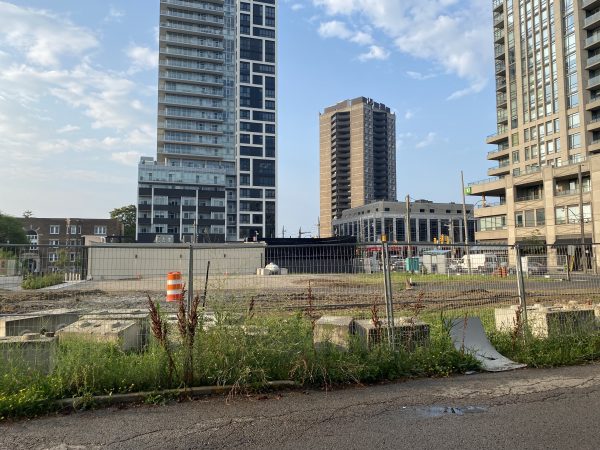
On the north-east corner of Bathurst and St. Clair West sits a snazzy purpose-built condo sales office, ostensibly there to promote Foret, a giant three-tower project from Canderel Residential and Kingsett Capital, which has a portfolio worth $19 billion and an as yet untouched $180 million affordable housing fund.
For decades, a car wash occupied the site. It was decommissioned and sold in the mid-2010s. The heavily polluted property lay fallow for several years as part of an anaerobic decontamination process. Meanwhile, in the bureaucratic background, the developers and the city slogged their way through the elaborate re-zoning process. It took three years and council signed off in June, 2020. The clean-up gear disappeared about two years ago.
Foret is a stone’s throw from the St. Clair West subway station and about every urban amenity one could name. It is planned to have over 1,100 units, which means it could become home to over two thousand people. What’s more, the project will include a new park.
However, Foret’s start date has come and gone. The application is “under review,” according to the city’s development application website. Consequently, month after month after month, that sharp looking sales office remains shuttered — in the midst of a housing crisis.
Why?
I’m sure there are all sorts of plausible explanation/justifications — interest rates! labour shortages! — but perhaps this huge project is merely another example of a builder timing the market. And it certainly wouldn’t be the only one.
What made me think of Foret was a laugh line that came out of the mouth of Doug Ford’s new minister of municipal affairs and housing, Paul Calandra yesterday. The government, he said during his inaugural presser, is considering implementing a `use it or lose it’ policy for approved Greenbelt projects. “We are in a housing crisis,” he said, according to the Globe and Mail’s account of his remarks. “We have to put shovels in the ground and we are relying on our partners in the development industry to get those shovels in the ground faster.”
There’s an immense amount of high-grade Greenbelt manure flowing freely from Queen’s Park these days. But Calandra’s promise is particularly ripe, especially given the fact that in the more urbanized parts of the city, use-it-or-lose-it regulation could actually help ease the housing crisis that Ford & Co. claims to keep them awake at night.
With his comment, Calandra raised — surely unintentionally — a beguiling prospect for further reforming Ontario’s planning laws, and especially those that regulate development in high-cost urban areas. What if the province could wade in and tell, say, Canderel and KingSett to get a move on? What if there was some form of penalty for developers that are ragging the proverbial puck because they’ve calculated that their returns will be higher if they wait?
Here’s another question: how about those projects where the builder has found an excuse to pull the plug on pre-sales, return everyone’s deposit and then re-list at higher price points? Could a use-it-or-lose-it policy put a halt to this especially odious form of greed?
It’s worth noting the Tories have added what amounts to a use-it-or-lose-it policy elsewhere in their reforms, but one that works in the opposite direction. This amendment to the Planning Act forces municipalities that list properties on heritage registries to follow through with a formal heritage designation within two years, after which the listing expires.
John Tory, when he was quote-unquote running for mayor last summer, also bruited the notion of a use-it-or-lose-it approach to planning approvals, which he pledged to bring about using his strong mayor superpower. Under his plan, as the CBC reported at the time, developers would have a certain window to execute on approved applications or face losing the rezoning, as well as unspecified tax penalties. At yesterday’s council meeting, in fact, a motion from Mike Colle asking for a staff report on adding `use-it-or-lose-it’ conditions to development approvals passed by a show of hands.
There are, of course, problems with this approach, not least the building industry’s objections. The city could, in theory, rescind a re-zoning approval on some site. However, if the application aligned with planning policies and the city’s original decision, the Ontario Land Tribunal would overturn such a decision in a flash.
It’s also true that some delays are legitimate: the market can become sluggish enough to warrant pausing a project, contractors and sub-contractors are a finite resource, and so on.
Ford & Co., of course, have absolutely no intention of coming through on this threat. They know — as do we all — who butters their bread, which means that forcing builders into the market before they’re good and ready to earn a bundle seems highly unlikely.
Still, Calandra, perhaps unwittingly, has unlocked a pandora’s box that is well worth opening — you know, the one that contains the building industry’s dirty little tactical secrets. All these firms know precisely how the game is played, and their profit optimization strategy (“staging”) is not unlike the one adopted by those infuriating toy makers that goose consumer demand by throttling the supply of an especially desirable item just before Christmas.
My view is that if Calandra’s idea were applied everywhere and not just the Greenbelt, it would call the building industry’s bluff. After all, if there is actually a housing crisis — and there is — then the builders have nothing to fear: their condos or apartments will get snapped up, and the thousands of (notional) occupants of all the Forets in this city will finally have places to live.




